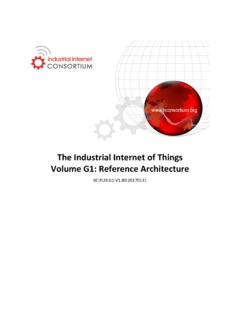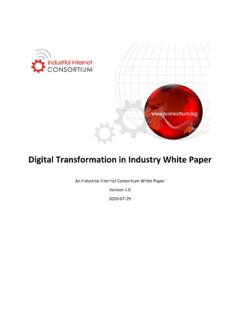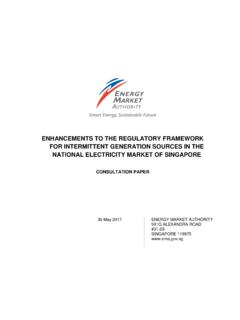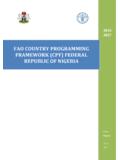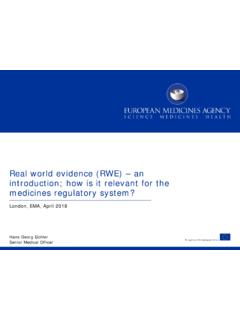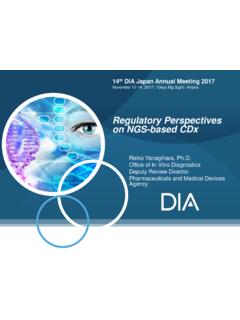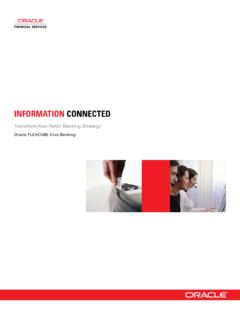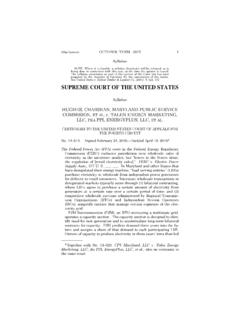Transcription of The Industrial Internet of Things Volume T3: Analytics ...
1 The Industrial Internet of Things Volume T3: Analytics framework IIC:PUB:T3 :PB:20171023 Analytics framework Contents IIC:PUB:T3 :PB:20171023 - ii - Copyright 2017, Industrial Internet Consortium, a program of the Object Management Group ACKNOWLEDGEMENTS This document is a work product of the Industrial Internet Consortium Industrial Analytics Task Group, co-chaired by K. Eric Harper (ABB), Wael William Diab (Huawei), and William Sobel (VIMANA). Portions of this technical report are contributed from an IIC white paper: Industrial Analytics The Engine Driving the IIoT Revolution (2017) 1. EDITORS The following persons (in alphabetical order) have edited the content in this document: Diab, Wael William (Huawei) Harper, K. Eric (ABB) Lin, Shi-Wan (Thingswise, LLC) Mellor, Stephen (IIC) Waddell, Russel (AMT) AUTHORS The following persons (in alphabetical order) have authored the content in this document: Anderson, Nina (AMT) Diab, Wael William (Huawei)* French, Terry (Denso Corporation) Harper, K.
2 Eric (ABB)* Lin, Shi-Wan (Thingswise, LLC)* Nair, Dinesh (National Instruments)* Sobel, William (VIMANA)* * Authored the original white paper and/or contributed substantive material to this framework 1 Diab, Harper, Lin, Sobel, Industrial Analytics : The Engine Driving the IIoT Revolution , March 2017, IIC, Analytics framework Contents IIC:PUB:T3 :PB:20171023 - iii - CONTRIBUTORS The following persons have contributed valuable ideas and feedback that have significantly improved the content and quality of this document: Chatterjee, Chanchal (Dell EMC) Guang, Liang (Huawei) IIC ISSUE REPORTING All IIC documents are subject to continuous review and improvement. As part of this process, we encourage readers to report any ambiguities, inconsistencies or inaccuracies they may find in this Document or other IIC materials by sending an email to Analytics framework Contents IIC:PUB:T3 :PB:20171023 - iv - CONTENTS 1 Overview.
3 1 Introduction .. 1 Purpose .. 1 Scope .. 1 Structure .. 1 Audience .. 2 Use .. 2 Terms and Definitions .. 2 2 Typographical and Linguistic Conventions and Style .. 3 Relationship with Other IIC Documents .. 3 2 Business Viewpoint .. 4 The Industrial Internet of Things .. 4 Creating Business Value .. 4 The Value of Industrial Analytics .. 5 3 Usage Viewpoint .. 7 Analytics in 8 Getting Started with Industrial Analytics .. 8 4 Functional Viewpoint .. 9 Analytics Architecture Objectives and Constraints .. 10 Analytics Functionality .. 11 5 Implementation Viewpoint .. 13 Design Considerations .. 13 Analytics Capacity Considerations .. 17 Analytics Deployment Models .. 17 Types of Analytics .. 18 Deployment Location .. 19 Deployment Phase .. 19 Data Pre-Processing, Transformation and Curation .. 20 6 Artificial Intelligence and Big Data .. 22 Big Data Analytics .. 22 Artificial Intelligence .. 23 Machine Learning.
4 24 Deep Learning .. 28 7 Analytics Methods And Modeling .. 30 Analytic Methods and 30 Streaming Real-time Analytics .. 30 Batch-oriented Analytics .. 33 Analytics Model Building .. 36 Algorithm selection .. 36 Cross-Validation .. 37 Analytics framework Contents IIC:PUB:T3 :PB:20171023 - v - Performance metrics .. 37 8 System Characteristics and Crosscutting Functions Related to Analytics .. 38 Safety .. 38 Security .. 39 Data Management .. 39 Connectivity .. 40 Annex A Example Analytics Standards .. 41 Annex A Section 1 STANDARDS ECOSYSTEM .. 41 Annex A Section 1, Subsection 1 Manufacturing Standards Ecosystem .. 43 Annex B Revision History .. 45 Annex C 46 Annex D Glossary .. 47 Annex E References .. 48 Index .. 48 Use of Information Terms, Conditions and Notices .. 49 FIGURES Figure 1-1 IIC Technical Publication Organization .. 3 Figure 2-1 Importance of Industrial Analytics considered by business leaders and industry analysts.
5 7 Figure 4-1. Analytics Mapping to the Industrial Internet Reference Architecture .. 11 Figure 5-1 Types of Analytics based on its applications .. 18 Figure 5-2 A deployment pattern of various type of Analytics .. 19 Figure 5-3 A deployment pattern of Analytics during its different lifecycle stages .. 19 Figure 6-1 Example of Multi-Typed Data Processing in Big Data Analytic Systems .. 23 Figure 6-2 Artificial Intelligence (AI) .. 24 Figure 6-3 Workflow for developing analytic models .. 24 Figure 6-4 Mapping features to failure conditions for a motor .. 25 Figure 6-5 Spectrum feature engineering 26 Figure 6-6 Health assessment using Gaussian Mixture Model .. 27 Figure 6-7 Taxonomy of machine learning algorithms .. 27 Figure 6-8 Deep learning workflow .. 28 Figure 6-9 Taxonomy of deep learning algorithms .. Error! Bookmark not defined. Analytics framework Contents IIC:PUB:T3 :PB:20171023 - vi - Figure 7-1 Lambda Architecture .. 31 Figure 7-2 Lambda Architecture - Streaming and Batch for IIoT.
6 35 Figure 7-3 Kappa architecture .. 35 Figure 7-4 The model building process .. 36 Figure 7-5 Splitting data for cross validation .. 37 Figure 7-6 Confusion matrix showing types of classification errors for a binary classification problem .. 38 Figure 8-1 SysML for specifications, analysis, design, verification and validation of engineering models 41 Figure 8-2 Manufacturing has a numerous standards that relate to analytical methodologies .. 43 Figure 8-3 Geometric design related standards .. 44 TABLES Table 2-1: Ranking of future importance of advanced manufacturing technologies by executives .. 5 Table 3-1: Industrial Analytics Requirements .. 9 Table 4-1: Industrial Analytics Capabilities .. 12 Table 6-1: Industrial Analytics Design Considerations .. 16 Table 7-1 Machine-learning algorithm options for building analytic models.. 37 Analytics framework 1: Overview IIC:PUB:T3 :PB:20171023 - 1 - 1 OVERVIEW The Industrial Internet of Things (IIoT) seeks to connect Industrial assets and machines the Things to enterprise information systems, business processes and people who operate and use them.
7 Advanced Analytics is at the core of this next-generation level of integration and, when applied to machine and process data, provides new insights and intelligence to optimize decision-making significantly and enable intelligent operations leading to transformational business outcomes and social value. These new insights and intelligence can be applied across any level of any industry if the appropriate data can be collected and Analytics applied correctly. If data is the new oil, data Analytics is the new engine that propels the IIoT transformation. INTRODUCTION As a fledgling discipline combining advances in mathematics, computer science and engineering in the context of Information Technologies (IT) and Operational Technologies (OT) convergence, Industrial Analytics plays a crucial rule in the success of any IIoT system. Industrial Analytics has unique requirements, characteristics and challenges compared to business Analytics and so requires special considerations in its implementation.
8 Since Industrial Analytics is in its early stage of development, much needs to be explored. This technical report describing an Industrial Internet Analytics framework is intended to spur discussions and research, and speed up the development and maturity of this indispensable technology. PURPOSE This Industrial IoT Analytics framework document provides guidance and assistance in the development, documentation, communication and deployment of Industrial Internet of Things Analytics Systems. SCOPE This document supplements the IIC Industrial Internet of Things Reference Architecture (IIRA)1 by detailing Industrial Analytics crosscutting concerns. It provides the concepts and components required to create a viable analytical system and the characteristics of same so the technologies employed provide the necessary services to perform successfully and correctly in an Industrial setting. This document presents an architectural framework of Industrial Internet of Things Analytics systems using the same approach as the IIRA, specifically the architecture viewpoints (business, usage, functional and implementation), which in turn was based on ISO/IEC/IEEE 42010:2011 architecture concepts.
9 STRUCTURE This document is organized as follows: 1 Analytics framework 1: Overview IIC:PUB:T3 :PB:20171023 - 2 - Chapter 2 Business Viewpoint Chapter 3 Usage Viewpoint Chapter 4 Functional Viewpoint Chapter 5 Implementation Viewpoint Chapter 6 Artificial Intelligence and Big Data Chapter 7 Analytics Methods And Modeling Chapter 8 System Characteristics and Crosscutting Functions Related to Analytics Annex A Example Analytics Standards AUDIENCE This document is intended for IIoT system architects and business leaders looking to successfully deploy Industrial analytic systems. USE The Industrial Internet of Things Analytics framework is intended as an architectural template for system architects to create a concrete architecture tailored for the requirements of a specific IIoT system; to assist in understanding and communicating the overall system among its stakeholders; and to implement the architecture to meet the unique system requirements.
10 TERMS AND DEFINITIONS Since this document is intended to address both IT and OT, the following terms and definitions that are key to understanding this document are: AI: Artificial Intelligence Analytics : Analytics may be broadly defined as a discipline transforming data into information through systematic analysis Architecture framework : conventions, principles and practices for the description of architectures established within a specific domain of application and/or community of stakeholders1 ICT: Information and Communications Technology Industrial Analytics : Industrial Analytics is the use of Analytics in IIoT systems IT: Information Technology OT: Operational Technology CONVENTIONS Given that the document is non-normative, all must , may and should statements are to be interpreted as English language and not as in RFC 2119 [IETF-RFC2119]. 1 ISO/IEC/IEEE 42010:2011 Analytics framework 1: Overview IIC:PUB:T3 :PB:20171023 - 3 - TYPOGRAPHICAL AND LINGUISTIC CONVENTIONS AND STYLE Terms that require definition are rendered in italics.

